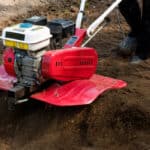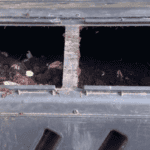Our site is reader supported, this means we may earn a small commission from Amazon and other affiliates when you buy through links on our site.
I’ve been a gardener and nurseryman for over 20 years, mostly working in my family nursery and garden centre. With this in mind, we’ve always had a composting system using large bays. I’ve seen the benefits of composting waste and turning it into money, or at the very least, into black gold (compost) I can mix into the flower beds and do my bit to reduce waste and help the environment.
However, when it comes to composting at home in my own garden, I’ve found that a compost bin, even if you have a small garden like me, is a great addition and is an excellent way for beginners to make compost from their kitchen food waste. This includes waste cardboard, shredded paper, and outdoor waste such as leaves, weeds and grass and turns it into usable fertile compost I can use in my raised beds.
It’s incredible the things you can put into a compost bin. The problem is, when it comes to choosing the best compost bin, there is alot of choice.
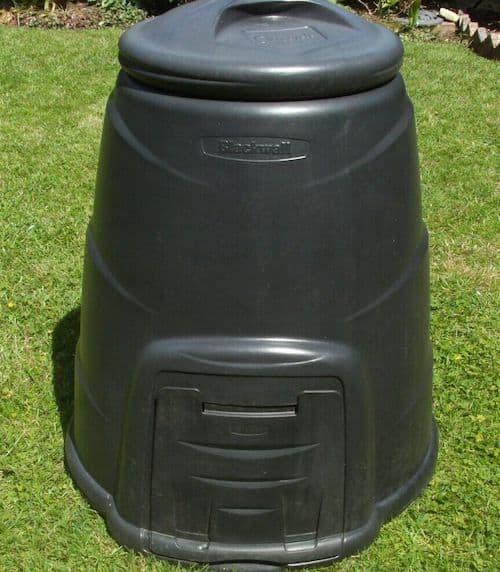
I’m a fan of this Blackwall 330L Black Compost Converter for those looking for a larger compost bin. It’s nice and simple, decent quality and easy to use. I like that it has a wider base, which aids microbial action which basiclly helps to breakdown waste into better quality compost. I will say that it’s not the cheapest, but it’s a nice decent size, does the job, and has a nice sliding door at the bottom. I have found that depending on what you compost, it generally takes around 6-12 months to make some compost.
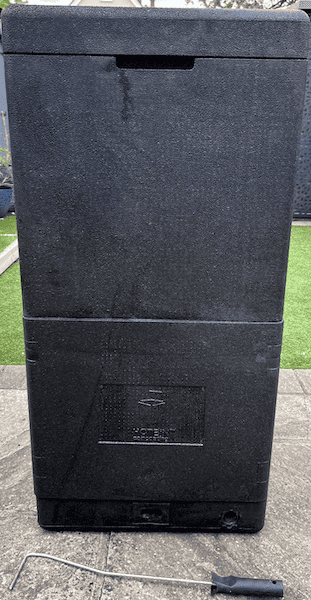
However, I’m also a fan of the Hotbin 100L Mini Composter as you can make compost in as little as 2-3 months, although I found that if you leave it in for six months, it makes amazing compost. Whereas, with good management and using a compost mixer to air the compost, it takes around nine to twelve months to make compost in a traditional compost bin. Basiclly, it’s just an extra insulated compost bin, about the size of a smaller wheelie bin, with some fancy features, including a built-in thermometer. It can easily reach 150 degrees in the centre, significantly speeding up the composting process. I think it’s a great piece of kit and a good choice for smaller gardens and well worth considering.
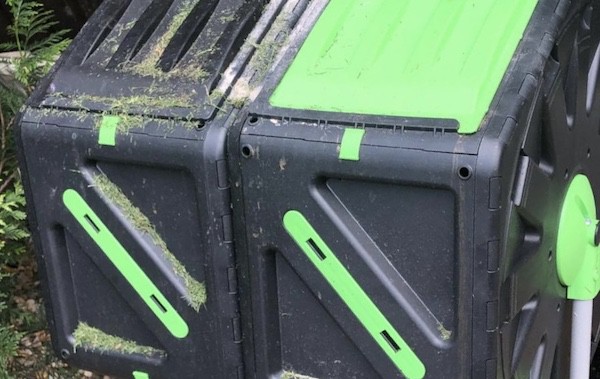
Another option to speed the process up is to invest in a compost tumbler, which I first came across about 5-6 years ago. However, for this review, I wanted to stick with the tried and tested humble compost bins as they are very affordable and a great way to get a taste of composting and what it takes. I’ve also previously talked about wormeries as well as how to setup a wormery which are also a great way to recycle kitchen waste.
Before I get into the more detailed reviews further down, I want to quickly explain and give a few tips on how to use a compost bin and, more importantly, what to put in a compost bin and how to layer it.
Using a compost bin
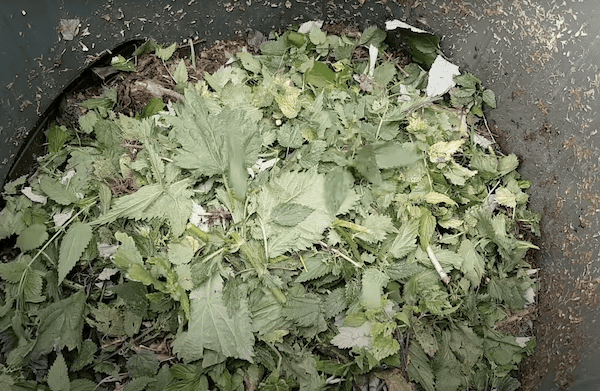
The first thing to consider is how much of each type of material you put into your compost bin. Basiclly, you have two types, carbon rich material and nitrogen rich material.
Carbon rich waste is things like cardboard, dead leaves, sawdust, straw, paper, pines needed and things like brown twigs and sticks. These are all carbon rich waste materials. Carbon needs to make up the bulk of your compost bin or at least 50-70% of it.
Nitrogen rich waste is things like green plant cuttings, kitchen waste such as peelings, and apple cores, basiclly anything you put in your kitchen waste bin is good for your compost bin. You can also put grass slipping in there, but be careful not to use too much as they are fine clipping and very high in nitrogen. I’ve also done a guide on what you can and cannot put into a compost bin here.
I have found that the best ratio is two parts carbon to one part nitrogen and that in volume. It’s not exact, and anywhere between this and 50/50 seems to work well for me.
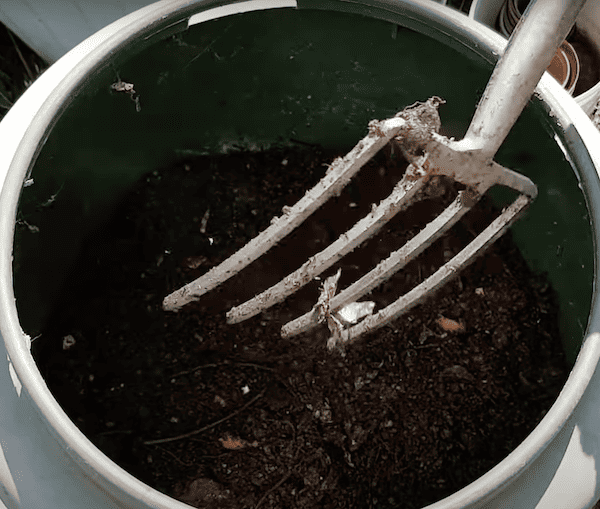
A couple of other tips: use thin layers of carbon and nitrogen waste to build your compost bin up. I start with carbon waste (brown), and I often use sticks and leaves at the bottom as it allows for air gaps, which is crucial because it becomes more compact at the bottom. I also like to mix the compost bin with a compost mixer once a week, and I make sure I add water to each layer as that is essential when making compost. I also like to have mine with an open base on top of the soil so worms can make their way into the compost and play their part. I also like to place the compost bin onto a large piece of cardboard before filling it. I also like to shed some waste with my garden shredder or my wood chipper which also shreds green waste making it compost faster
To sum it up, you need the right ratio of materials, air and water, and you will have beautiful black compost in around 6-12 months or even sooner with a well-insulated compost bin or hotbin.
Best Compost Bin Reviews
1. Blackwall 330L Black Compost Converter
Buy on Amazon.co.uk

Firstly I really like that my Blackwall compost bin is made in the UK from recycled plastic. This Blackwall 330L Black Compost Converter is ideal for recycling garden waste and kitchen scraps and is one of the larger sizes while not being too large so it’s also a good option for small gardens but it’s also a decent capacity. This composter doesn’t require any assembly so it’s ready-to-go when you unpack it which is also plus.
The Blackwall 220L Composter is very well made and certainly robust when compared to some cheaper, dare I say, Chinese-manufactured alternatives. Its green colour blends in amongst the green foliage in most gardens so it’s not unsightly which has always been my main issue, how well it blends into the background so as not to look like an eyesore. I recommend that you position it on top of the soil where worms can enter from underneath because there is no bottom to the bin. Most worms do help in composting food scraps and other organic material.
If you’re concerned about harmful worms, you can purchase, at extra cost, the separate base that completely prevents vermin of any sort from entering. However, if you opt to use the separate base and perhaps place the bin on hard ground, you might need to add an agent to break down the compost. I’ve always positioned mine on top of soil but this is what I’ve been lead to believe so just keep this in mind.

The wide hatch at the base of the composter gives you easy access when you want to remove some compost after around 6-12 months. There’s an indented handle hold to pull to open the hatch and you then scoop out the compost you want from the bottom of the pile.
The recycled plastic composter is UV-stabilised to counteract degradation by harmful UV-rays. It creates a secure environment for composting whilst retaining heat and moisture levels which is important. The lid is stiff and the chances of blowing off in wind are almost zero, let’s just say it seems to bee tight enough. Plus, it’s a convenient lift-off design for easy access and cleaning in between loads.
Pros
- Static composter made from recycled plastic.
- Capacity is 330L.
- Needs no assembly.
- Removable extra wide hatch.
- Comes with a full user guide.
- Push-fit windproof lid.
- Carbon footprint certified by the Carbon Trust.
- British made.
- Dimensions: 80cm (diameter); and 100cm (height).
Cons
- The push-fit lid is also quite hard to take off but this can be a bonus so its also a pro.
My recommendation
This Blackwall 330L composter is a great bin and is for me the best option for most people, it’s UK made which I support, and overall, good quality product that gets the job done. I like that it’s also a good size compost bin at 330L while still being fairly compact, making it ideal for smaller and larger gardens. Honestly for most people, you can’t go wrong with this model.
2. Hotbin 100L Mini Composter
Buy on Amazon.co.uk

This Hotbin Mini Composter is the second of the hot composting models in my review but this is my favourite and probably the best choice for smaller gardens or who even live in a flat and have a balcony to put the composter on. What I really like is that you can actually make compost in around 3 months, but if you are patient, I would leave it for even longer to get an even darker premium compost. If you need compost fast, for example, if you have a small garden but plenty of garden waste, this is a good option.
I also like that it’s easy to assemble this black polypropylene compost bin. Then, just set it in the sun or shade and start feeding it. To give you an idea, it can handle 2.5kg or 5L of your kitchen and/or garden waste a week. It produces mulch in 30 days but it takes at least 90 days for your compost. This is a significantly shorter period than with cold composting bins which includes the Blackwall compost bin but don’t forget at 100L it’s also a third of the size.

The full lid on the top opens all the way for you to put your scraps in. And the removable door at the bottom in the side lets you access the compost at the base of the pile.
A bonus for your plants and shrubs is that this model also produces compost tea. This is the liquid that runs off in the production of the solid compost. This bin collects it in the bottom of the composter, and you can siphon it off into a bottle. You need to dilute it before giving it to your plants as it’s pretty strong but it is a great natural feed for plants.
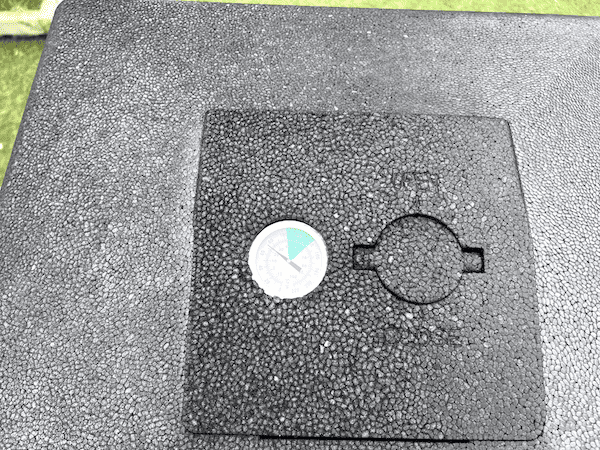
You do need to watch the temperature in your composter and stir the contents (stick included in purchase) when the temperature gets down low enough. However, this model has a thermometer in the lid that you can easily read to let you know it’s time to stir. The air vent in the lid lets you add more oxygen to help raise the temperature as well. Personally, I think a decent compost aerator does a better job but it’s a nice addition to the kit.
Pros
- Black polypropylene composter that’s easy to set up.
- Capacity is 100L.
- Designed for smaller gardens.
- Locate in either sun or shade.
- Full hinged lid at top to access inside to deposit waste.
- Adjustable air vent in the lid.
- Removable door at bottom to remove compost.
- Composts garden waste and all food.
- Produces mulch in 30 days and compost in 90 days.
- Handles 2.5kg or 5L of waste per week.
- Collects liquid (compost tea) from the composting process; drainable.
- Includes: thermometer; bottle for compost tea; raking stick; 25L of bulking agent.
- Dimensions: 45cm (width); 45cm (depth) and 112.5cm (height).
My recommendation
If you don’t produce much garden or kitchen waste or you don’t have much space for a compost bin, this Hotbin Mini Composter is well worth considering. This has a compact capacity of 100L so not to large and is shaped like a pillar that can easily fit into a corner on your garden or even a balcony or patio. The liquid tea as well as solid compost keeps your plants happy all year long. I think it’s well thought out and the process is much faster so even though it’s smaller, you can use the compost much faster and keep filling as you go. It’s a little on the expensive side, however, I think it’s well worth considering and a great option if you need a smaller but productive option.
3. Green Johanna 330L Hot Compost Bin
Buy on Amazon.co.uk

This Green Johanna 330L Hot Compost Bin, is one of two composters in my review that use the hot compost process. (The Hotbin Mini Composter is the other one.) I explain the hot composting process fully in the Buyer’s Guide. But in summary, it lets you compost a wider selection of waste, works at a higher heat than regular (cold) composting and produces compost in less than half the time. I think this is a good alternative to the Blackwell compost bin because of the size being identical but this is also more expensive.
This hot compost bin is green and shaped like a barrel that tapers a bit at the top. This shape helps with the passive air flow and lets the contents settle to the bottom of the bin.
The bin has a full lid at the top that fits firmly and securely. Take off the lid to put waste into the bin. What’s different about this bin is that it’s insulated to keep in the heat that’s generated by the bacteria and other microbes working away. This is what raises the temperature to create the hot environment.
As with any composting process, oxygen is a key element. Simply twist the lid to increase or decrease the air flow to the inside.
To access the compost, use one of the two doors at the bottom of the bin. There are indented handles to lift the doors off. Just do this the couple of times a year you need to use the compost.
This Green Johanna Hot Compost Bin does have a base, but it’s not solid. The base has holes in it large enough for worms to pass through. Worms are very helpful in the decomposing process and I have found should be encouraged.
You do need to keep an eye on the temperature in your composter. Once it comes down to 50C, open the lid and use the mixing stick (included) or a compost aerator to stir up the contents of the bin. This adds more air into the mix and raises the temperature again. I find that this is best done once a week with all compost bins.
And speaking of the temperature, if you live in a climate that’s significantly colder in the winter like me, you need to wrap your compost bin up for the cold months. Use horticultural fleece or purchase a ready-made composter bin jacket although this tend be be well over priced.
Pros
- Conical cylindrical compost bin made of green plastic.
- Constructed from plastic resin.
- Capacity is 330L.
- Bin is insulated to keep the heat in.
- Innovative and patented ventilation system to allow oxygen into the process.
- Base plate slits allow macro-organisms to enter and leave.
- Full twist-lock lid at top to put waste into the drum.
- Two doors on sides at bottom to remove compost.
- Uses a hot composting system for faster decomposition.
- Compost two parts food waste to one part garden waste.
- Includes mixing stick.
- Dimensions: 80cm (diameter); and 95.3cm (height).
My recommendation
The Green Johanna Hot Compost Bin is an excellent large composter that uses the hot composting process, and it’s a good option if you like the idea of hot composting as the process from waste to compost is shorter. Throw in most of your kitchen and garden waste and wait just a few months for rich compost to be ready. Just keep an eye on it to ensure that the worms and microbes have a hot enough environment to work their magic. Personally, if you want to make compost as quickly as possible, this is a good option, if not then the Blackwell compost bin will be just as good it just takes longer.
4. Easipet BeeHive Style Wooden Compost 328L Bin
Buy on Amazon.co.uk

The Wooden Compost Bin 328L looks just like a wooden beehive and I’ll be honest, the beehive design is what caught my attention. It will sit disguised as such in your garden. The sides of the composter are wood slates arranged horizontally with spaces between them for ventilation. The roof/lid is also wooden in a gable style.
The roof is hinged and opens up fully so you can access the inside of the bin. There’s even a stick so you can prop the lid open and use both hands to empty your waste container into the bin.
At the base of the front side is the door to access the compost. It’s held in place by a single wooden peg that doesn’t look too sturdy. This access door is two slats high out of a total bin height of six slats. But it’s the width of the bin so there’s quite an opening through which to get at the compost.
One downside is that this beehive compost bin doesn’t have a base. If you place it on grass or earth it probably will attract vermin and other creatures to feed and nest in your compost pile, but I think it’s the rats you need to watch out for. I’ve found that a well-managed compost bin always attracts less vermin. You may need to put it on a solid surface such as concrete blocks, to keep the integrity of your compost.
Pros
- Wood compost bin with a gabled wood lid.
- Sides arranged as slats with some space between them horizontally for ventilation.
- “Roof”/lid opens fully on a hinge and is propped up.
- Removable panel in the base of one side to take out compost.
- Dimensions: 74cm (width and depth); and 80cm (height to tip of roof).
Cons
- Panel at base secured only by a wooded peg.
- Maybe a little flimsy than you might expect
My recommendation
If you really don’t like the look of “ordinary” compost bins (especially the “Dalek” ones), the Wooden Compost Bin shaped like a beehive could be the answer to your composting conundrum and they can become a feature of the garden. Although the construction of this bin seems to be a bit flimsy, it does the job and looks good doing it. Feel free to stain or paint it to fit in with your garden colour landscape.
5. 4smile 300L Garden Composter Bin
Buy on Amazon.co.uk

This 4smile 300 Litre Garden Composter is a bestseller and for good reason, its gets the job done and its affordable. I love how easy it is to assemble without using any tools at all. It comes flat-packed, with the small parts protected inside the larger components. All you have to do is put the panels together; these easily click into place within minutes and are much easier than some of the compost tumblers I’ve seen.
The assembled composter is strong. It being a cube makes it practical, fitting neatly in the corner of your garden. Its grey/green colour also blends in well with your garden landscape.
Another thing that stands out is the hinged lid, which lets you easily place your suitable waste into the bin. It also prevents essential heat from escaping whilst keeping pests out. Accessing ready compost is also easy thanks to the removable hatch door located at the base of the bin. The large size of this composter is a big plus, as it has a 300L capacity. Its weatherproof plastic construction protects against external elements, including rainwater and the harmful effects of sunlight.
Pros
- Plastic static garden composter.
- Large 300L capacity.
- Integrated hinged lid.
- Hatch door at the bottom.
- Size (cm): 83cm (height); 61cm (width); and 61cm (depth).
Cons
- No catch on the lid.
- Plastic construction is a little flimsy.
My recommendation
What greatly appeals about this 300 Litre compost bin is the ease of assembly – it’s simple and quick but also the price, it’s super cheap. The large capacity of the bin is also something to boast about. I recommend the 4smile 300 Litre Garden Composter for use in homes with heavy garden waste, and people who are not so keen on assembly and have a smaller budget. I think having two or three of these and rotating the compost would be a brilliant and affordable setup.
Compost Bin Buyer’s guide
To make the best decision in buying your compost bin, there are a few issues to consider. I cover these in an excellent Buyer’s Guide in my article that reviews Compost Tumblers. This review also gives you the differences between compost bins and compost tumblers so you’re sure that you’re selecting the right composter for your needs.
For this Buyer’s Guide I address something that’s becoming more common in the composting arena – the issue of cold composting versus hot composting. Most domestic composting uses the cold composting process. But hot composting is becoming more popular as it’s quicker to decompose the waste to compost and you can use a wider variety of kitchen waste (including meat and fish bones) in the process.
In the review above, there are two hot composting models for you to take a look at.
Cold composting
This is the composting process we’re all familiar with. Composting relies on the natural decomposition process of organic materials that nature goes through. Microorganisms in the soil and the waste, along with moisture and oxygen, break down the organic matter overtime. The heat produced by this is lost in cold composting.
When you buy a composter it’s usually a barrel shape and made of plastic. You put it in a relatively sunny place in your garden and regularly feed it garden and kitchen waste. Wait six or so months and look, you have a rich compost at the bottom of the pile for your flower, shrubs, vegetables and so on.
But it’s not quite that simple. There are rules and guidelines to follow. The most important is the kind of waste you put into the process. You can’t use dairy, meat, fish, baked goods, fatty foods and other types of waste from your kitchen. And don’t put in toxic plants or plants that are diseased.
Many experts recommend that you fill up only 75% of the capacity of your composter with waste – preferable 40% of wet and green waste and 60% of brown and dry waste. You don’t have to be very accurate with this but try to get close to this ratio.
Decomposition in cold composting takes a long time. The temperature of the compost/waste pile remains low. You have to keep the pile moist in warm weather. You can check this when you turn the pile to mix everything up a bit. This also ensures that air gets into the waste and compost as decomposition won’t occur without it.
Hot composting
Hot composting also works with the natural decomposition process but adds in a few elements to speed it up.
The first element to add is heat. The two hot composting models in this review (Green Johanna Hot Compost Bin and Hotbin Mini Composter) are insulated to keep in the heat generated by the composting process. Bacteria which have adapted to working at higher temperatures break down the organic materials efficiently and quickly. The compost should warm up to 55?C to 60?C – that’s quite warm.
This heat speeds up the process and hot composting usually takes just half the time of cold composting – three or so months depending on the size of the composter.
A second element added is the kind of waste that you can throw in your hot composter. Some experts say that you can use meat, dairy and bones, while others say you should still avoid them. I think that this is a matter of experimentation with your unit and the quality of compost it produces with these.
You do need to add a fair amount of waste at the outset of your composting process, rather than in dribs and drabs as in cold composting. Cut everything up finely so it can decompose quickly.
And your hot compost pile does need some attention. Monitor its temperature. When it’s cooled down to 50?C, you need to stir it around to aerate it and to start the heat generation again.
And place your hot composting bin in the sun. This is another way to encourage the heat to build up.
Final conclusion
Whether you choose a compost bin or a compost tumbler, or whether you choose a cold compost or hot compost bin, you’re establishing a closer relationship with your garden by expanding its eco-system. Composting your garden and kitchen waste keeps it out of the landfill and finds a new purpose for things that still have use.
All the compost bins in this review are easy to use, though some do take a little more care and attention than others. But your garden will look better for receiving its nutrients from a product in which every ingredient was selected by you.
Last update on 2025-07-04 / Affiliate links / Images from Amazon Product Advertising API






